Acoustic Floor Systems
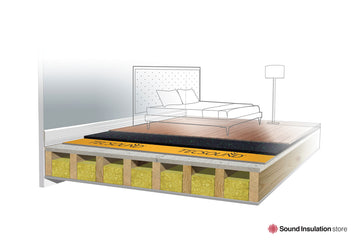
Wood and Laminate Acoustic Floor System
This acoustic floor system is high mass, high performance and low deflection. Allowing you to install your wood or laminate flooring directly onto the acoustic layer
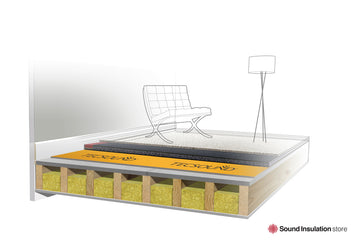
Carpet Finish Acoustic Floor System
This acoustic floor system is high mass, high performance and allows a soft carpet finish to be installed perfectly over the acoustic layers.
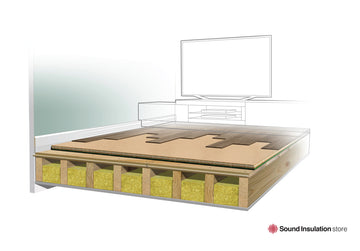
dB Panel 28 Acoustic Floorboard System
This acoustic floor system is a popular way of adding impact and airborne sound performance to your floor for conversions and New Builds in the UK.
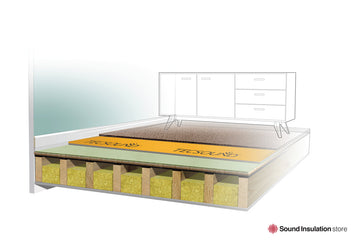
dB Panel 37 Straight to Joist Acoustic Floorboard System
This acoustic floor system is a straight to joist solution for replacing standard floorboards with acoustic flooring and retaining floor to ceiling height
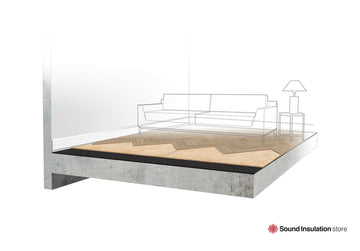
dB FFR Acoustic Underlay for Concrete Floor
Acoustilay is the original high mass acoustic underlay. This system show how to use it with a carpet finish

Acoustic Underlay for LVT
Our dB Matting 15 and Jumpax Heatpak together provide the perfect underlay for LVT (luxury Vinyl Tiles).

Acoustilay Underlay Carpet Finish
Acoustilay is the original high mass acoustic underlay. This system show how to use it with a carpet finish
How Do Acoustic Floor Systems Improve Soundproofing?
Combined with acoustic wall and ceiling systems, acoustic flooring can effectively reduce noise transmission in a residential or commercial space to improve privacy, comfort, and comply with Part E Building Regulations. This is achieved through three key principles:
- Insulation: Our acoustic flooring systems use materials like Rockwool Acoustic Insulation to absorb and dissipate sound energy, reducing reverberation in cavities.
- Isolation: Also known as decoupling, isolation involves creating a physical separation between the finished floor and subfloor, breaking direct sound paths.
- Mass: Adding dense materials to our acoustic floor systems also helps to block sound transmission. Materials like dB acoustic underlay absorb sound energy travelling through floors.
What Are the Different Types of Acoustic Floor Systems?
Our acoustic floor solutions include both acoustic underlay and timber floating floor systems. All are high-quality, including everything you need for effective soundproofing, but differ slightly depending on the floor finish and the acoustic performance level required.
Acoustic Floor Systems for Wood, Laminate, and Carpet Finishes
We have two systems which combine multiple acoustic layers. Your floor finish can be applied directly onto the acoustic layers, whether that’s a wood or laminate finish or a carpet finish.
These systems use materials such as Rockwool insulation, No More Ply construction board, and Tecsound for effective resistance to the passage of sound. Two different types of dB matting are used to allow for flex if required, depending on the floor finish.
dB Panel Straight to Joist Acoustic Systems
For installations in conversions and new builds, our dB panel systems are popular. These are straight-to-joist, floating floor systems which require no mechanical fixings and can be beneficial for retaining floor-to-ceiling height.
Acoustic Underlay Systems
We have three unique systems for applying acoustic underlay. These systems use Acoustilay or dB matting to add mass. Each system has been designed for different floor structures and finishes, including concrete flooring, LVT finishes, and carpet finishes.
Which Acoustic Floor System Is Best for Me?
Our acoustic floor systems are designed to provide everything you need for effective sound insulation, but choosing the right system needs consideration of a few factors:
- Floor Type & Structure: What floor type and structure will you be installing your acoustic floor system onto? For example, wooden timber beams or concrete.
- Floor Finish: What floor finish will you be using once your system is installed? Timber, hardwood, and laminate require low-deflection systems while carpet can benefit from a more luxurious feel underfoot and LVT needs a level, solid floor to be laid over.
- Performance & Noise Type: What level of performance are you looking for and is your noise source airborne, impact, or both?
- Budgetary Requirements: Our range can meet different budget requirements, providing effective sound absorption at an affordable price.
For expert advice that’s tailored to your project, contact our team online or give us a call.
Our Specialists On Acoustic Floor Systems
The Team At SIS Says:
“There are a number of questions that need to be answered before specifying the correct acoustic floor system for your project. What acoustic performance are you looking for? What are the issues? Are you trying to meet regulations?
“Next, we need to know what your proposed floor finish is. Laminate, wood, carpet, or LVT vinyl? What height can you afford to lose? And finally, what is your budget?”
Quality Acoustic Floor Systems to Meet Your Project Needs
A well-designed, high-performance acoustic floor system will effectively reduce noise, enhance comfort, and help you meet required regulations.
We have solutions built for a variety of spaces and specifications, from soundproofing new-build homes to offices and commercial buildings.
Explore our range and speak to our team for more information.

Acoustic Floor System
Are acoustic floor systems required by UK building regulations?
Part E Building Regulations require that new and converted residential buildings meet specific acoustic standards, between flats or apartments, hotels and rooms for residential purposes. Acoustic floor systems are part of meeting these regulations, helping to reduce impact and airborne noise between floors.
Can acoustic floor systems be applied for all floor finishes?
Our experts have created a range of acoustic floor systems which are effective for a variety of floor finishes. This includes carpet, wood, laminate, and LVT.
The acoustic solution will vary depending on your floor finish. For example:
- For carpets, softer underlays with some flex and deflection are preferred for greater comfort underfoot.
- For wood and laminate flooring, matting with low deflection provides a solid subfloor for the floor finish to be directly applied.
- LVT requires a thin, flat, and even system with low deflection and overlay boards to apply the flooring finish onto.
What’s the difference between an acoustic underlay and an acoustic floating floor system?
An acoustic underlay is a thin, resilient layer installed directly beneath floor finishes like carpet or laminate, providing moderate noise reduction. Acoustic floating floor systems create an isolated structure above the subfloor for superior reduction of impact and airborne noise.
How are your acoustic flooring systems installed?
Installation varies depending on the system you opt for. The general process is outlined in each system, be sure to check the specific instructions for your system before installing.
However, some systems require little disruption and can be installed over the existing floor structure. Others will need the client to remove the floorboards to expose the cavity, potentially level the floor, and install multiple layers of acoustic materials.

